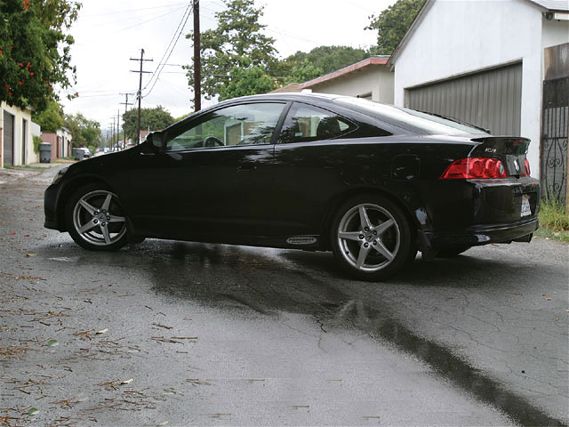 | 2005 Acura RSX-S -- Handling Part 1
| 2005 Acura RSX-S -- Handling Part 1
To the chagrin of aftermarket suspension tuners industrywide, Honda changed the suspension settings on its RSX in 2005. Between 2002 and 2004, the RSX rode on a combination forward MacPherson strut/rear double-wishbone design that didn't please a lot of the Honda faithful, many of which are still disappointed Honda didn't go with double wishbones up front for the latest DC chassis.
Perhaps to appease them, Honda made the changes to the '05 RSX, but as one suspension engineer exclaimed to us, "I wish Honda would just make up its frickin' mind!"
For 2005, the suspensions on both RSX models have a revised geometry, reduced ride height (a drop of 7mm from the old version), retuned bushings, thicker stabilizer bars, firmer damper settings, and something called "inversely wound" front coil springs that purportedly neutralizes unwanted steering input caused by spring windup.
That is, the left front spring is wound counterclockwise from the bottom up, while the right front spring is wound clockwise. In the '02-to-'04 models and on many other cars, the rotation of the springs on both sides is the same-counterclockwise.
The unwanted steering input that Honda is referring to is the spring rotation that occurs as the suspension is being compressed. With twin conventionally wound springs, both springs would rotate in the same direction under load. Honda believes that by using oppositely wound springs, this phenomenon will be offset, that the opposing springs will cancel each other out and create more stability.
The setup is used on other vehicles, too, like some older Porsches, but it's a spring maker's nightmare, according to head engineer Ed Flores from sport compact suspension specialists the Progress Group. He tells us CNC machines typically used to make springs are set up for counterclockwise-spun coils. Reversing the winding process is usually very involved and very expensive for manufacturers.
Flores also tells us it appears Honda detuned the factory rear coil springs with the DC5's revamped rear anti-sway bar. The factory spring rate has been dropped and the diameter of the rear anti-sway bar has gone from 19mm in diameter (for the '02-to-'04 models) to 21mm. We'll look into running an even thicker, adjustable bar next time.
For now Flores is going to beta test a version of Progress' spring kit for the 2005 RSX. The unfinished forward coils will have a spring rate of 280 lb/in. and the rears a rate of 500 lb/in. Flores will walk us through the process of removal and installation, and then give us a look into the Progress R&D routine.
For much of this work, all or part of the car will have to be in the air. If you plan to do something similar and have access to a lift, the job will go much quicker, but stands and a jack will net you the same results. Finally, always get the car re-aligned after any suspension tweaks. Some tire makers say negative camber is OK so long as you've got a suitable tire, but we say negative camber is cool only in extreme situations. Save your money, buy race tires, and go to the track.
Getting It RightWhen the DC5 came back after a week with a sagging ass, Flores had to find a quick way to correct the ride height and get the info he needed for Progress' spring people before any production runs went out. He figured the easiest stop-gap thing to do would be to alter the front springs and shore up the rears. Figuring out how far to go in the front and back, however, took some comprehension of load and ride heights, spring rates, and something called the "motion ratio."
The motion ratio is the leverage factor of the suspension arm that the spring is pushing against; in the case of the forward MacPherson strut suspension on the DC5, it's the knuckle and, by extension, the lower arm. The ratio, squared and multiplied by the spring rate, gives a wheel rate, which is said to be a better representation of a suspension's spring rate. Additionally, if the spring is mounted at an angle, the reduced motion of the spring must also be taken into account.
Flores gives us a couple of real-life examples. The ratio for many MacPherson strut setups is close to 1:1, which means if we trim 0.5 inches from the spring, it's going to result in an approximate 0.5-inch drop at the fender well. On a twin A-arm car, however, the motion ratio changes because the spring angle and ball-joint positions are different. The ratio in some cases can go up to almost 2:1, and in a layout like that, trimming .25 inches from load height will likely result in a drop of 0.5 inches in ride height. The rear suspension on the Type-S is configured this way, in part because the springs are mounted very far inboard.
The topic deserves a lot more discussion than we have room for. Suffice it to say, Flores has done this more than a few times, and chose to trim half a coil off the forward springs for a drop of about 3/8 inches in load height. The reduction corrects ride height and keeps the springs properly preloaded. As far as the rear springs, those were shimmed for more height. All of the new dimensions, including load and ride heights, have already been incorporated into Progress' current spring lineup.
Next Time
Alignment, chassis stabilization, running gear, and suspension adjustability for the street and track.
